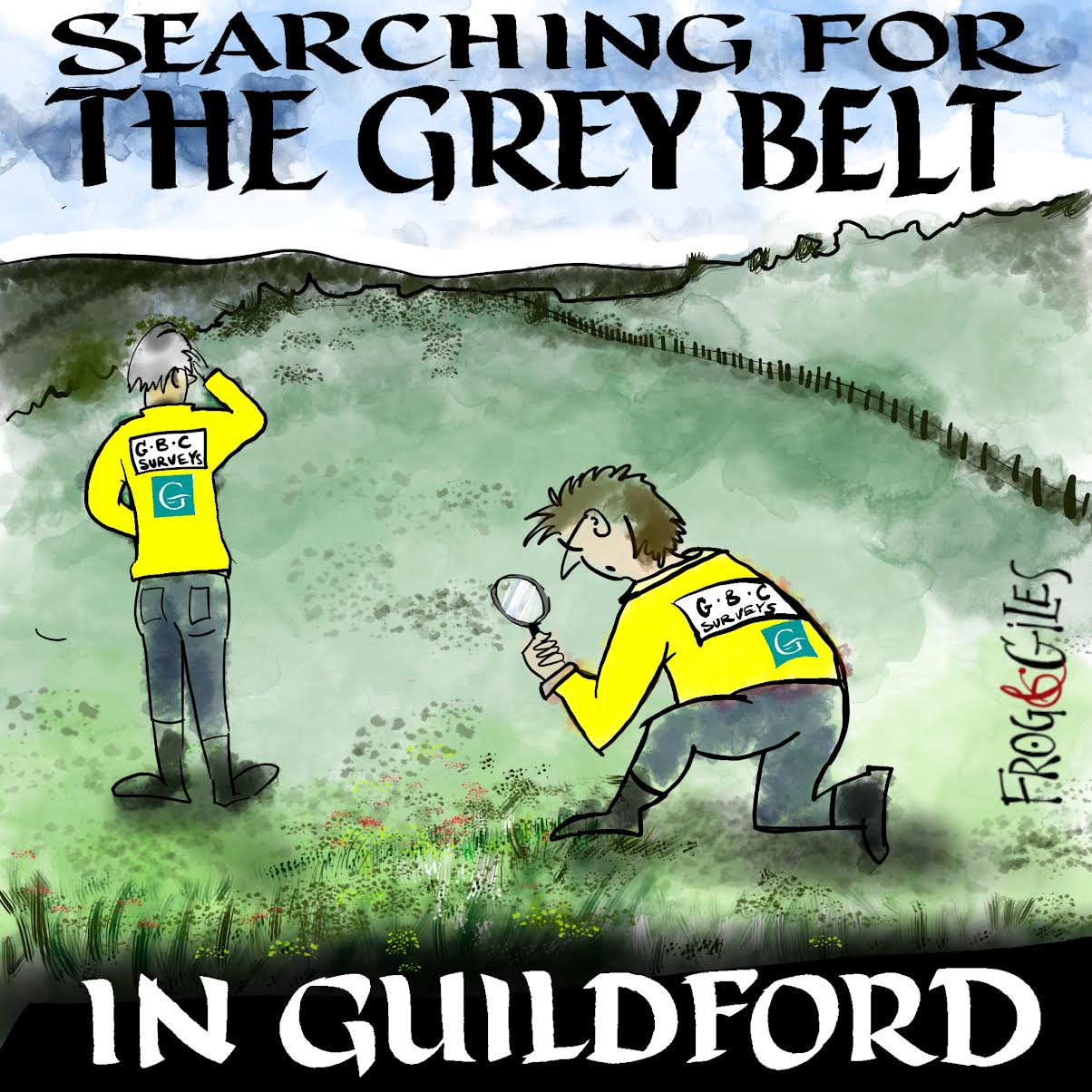 Abraham Lincoln
If given the truth, the people can be depended upon to meet any national crisis...
Abraham Lincoln
If given the truth, the people can be depended upon to meet any national crisis...
 Guildford news...
for Guildford people, brought to you by Guildford reporters - Guildford's own news service
Guildford news...
for Guildford people, brought to you by Guildford reporters - Guildford's own news service
Letter: The Roads Are Full of Cars – That’s the Issue
Published on: 21 Mar, 2023
Updated on: 21 Mar, 2023
In response to: Stop the Cycling Culture War and Admit We are Addicted to the Car
An excellent viewpoint from Mr Cameron. He raises the points very well that Guildford and Surrey are well behind in cycle infrastructure.
Public opinion polls show time and again wide support for more safe cycle options and it is a surprisingly small minority who make the complaints, and when doing so expose their bias and discriminatory views.
Mr Brewster’s comments are typical and show the issue faced by these “angry old men”. On one hand they complain the roads are full of cyclists yet on the other complain no money spent as cyclists make up less than 1 per cent of road users.
In reality the roads are full of cars, and this is the issue that needs to be looked at. We won’t stomach more road building and this is shown to do nothing to reduce congestion, and generally increases it.
Cycling is about normal people in normal clothes, moving around without cars.
Responses to Letter: The Roads Are Full of Cars – That’s the Issue
Leave a Comment Cancel replyPlease see our comments policy. All comments are moderated and may take time to appear. Full names, or at least initial and surname, must be given.

"Found any?" - "Nope, it all looks green to me!" (See Opinion: The Future is Congested, the Future is Grey)




Recent Articles
- Letter: All Three Major National Parties Are Relaxed About Green Belt Giveaways
- Updated: Ash Level Crossing Decision ‘Was Made Without Approval of Surrey Highways’
- Sara Sharif Trial Latest – ‘Fear and Violence Reigned’ in Sara’s Home
- Dragon Interview: Julia McShane leader of GBC’s Lib Dems
- Letter: Ash Bridge – We Need Accountability and Competence
- Letter: SCC’s Final Decision is Unlikely to Put an End to the Issue of the London Road Layout
- Only Cabinet Members Will Speak at SCC’s Meeting to Decide on London Road Scheme
- Highways Bulletin for November 25
- Notice: Winter Warmer Giveaway
- Further Technical Fault


Recent Comments
- Jane Hughes on Sara Sharif Trial Latest – ‘Fear and Violence Reigned’ in Sara’s Home
- John Ferns on Ash Level Crossing Will Close Before Opening of New Road Bridge
- Olly Azad on Ash Level Crossing Will Close Before Opening of New Road Bridge
- Roshan Bailey on Student Named Land Based and Horticulture Learner of the Year
- Frank Emery on Ash Level Crossing Will Close Before Opening of New Road Bridge
- Paul Robinson on Letter: The Active Travel Proposal Is the Safest Option for London Road
Search in Site
Media Gallery
Dragon Interview: Local Artist Leaves Her Mark At One of England’s Most Historic Buildings
January 21, 2023 / No Comment / Read MoreDragon Interview: Lib Dem Planning Chair: ‘Current Policy Doesn’t Work for Local People’
January 19, 2023 / No Comment / Read MoreA3 Tunnel in Guildford ‘Necessary’ for New Homes, Says Guildford’s MP
January 10, 2023 / No Comment / Read More‘Madness’ for London Road Scheme to Go Ahead Against ‘Huge Opposition’, Says SCC Leader
January 6, 2023 / No Comment / Read MoreCouncillor’s Son Starts Campaign for More Consultation on North Street Plan
December 30, 2022 / No Comment / Read MoreCounty Council Climbs Down Over London Road Works – Further ‘Engagement’ Period Announced
December 14, 2022 / No Comment / Read MoreDragon Interview: GBC Reaction to the Government’s Expected Decision to Relax Housing Targets
December 7, 2022 / No Comment / Read MoreHow Can Our Town Centre Businesses Recover? Watch the Shop Front Debate
May 18, 2020 / No Comment / Read More







Ruth Stone
March 21, 2023 at 1:52 pm
I completely agree with this. We need to change the culture of car supremacy.
Mark Bray-Parry
March 21, 2023 at 2:46 pm
“Cycling is about normal people in normal clothes, moving around without cars.”
This is true, and an aspect that sometimes gets lost in debate. I was recently in Utrecht.
I was aware of Netherland’s cycling culture but nothing quite prepares you for it. It wasn’t the numbers (though it is quite a picture seeing hundreds of cyclists on the roads). The diversity of the cyclists was particularly eye-opening: age, sex, fitness.
I didn’t see a single road bike with drop-down handlebars or cyclist clad on lycra. No high-vis or helmets. No sprinting of Strava segments. Everyone wearing everyday clothing and cycling upright.
This stark difference in cycling culture to the UK is the culmination of infrastructure changes in the 70s and 80s that focussed on pedestrians and cyclists rather than cars alongside decades of gradual cultural shifts instigated by the Dutch government.
The Dutch people I spoke to (at least those who were old enough to remember) spoke of conflict between cyclists and car users in the beginning but now there is an accord, if not quite unity, between all road users as well as pedestrians.
The UK is at the early stages of this process. It is important we keep pushing for changes to our infrastructure and culture that put pedestrians and cyclists first.
Now, time for me to put on my lycra and hop on my road bike to lay down some fastest segments on Strava during my daily commute. 🙂
Nathan Cassidy
March 22, 2023 at 9:18 pm
I agree, experiencing the situation in the Netherlands completely changes one’s idea of the diversity of people who will cycle when it is safe to do so.
I almost wish we English had two separate words, like the Dutch, who have “Wielrenners” for the Lycra-clad, and “Fietsers” for everyone else just going about their business.
Susi Felton
March 21, 2023 at 6:13 pm
Yes but remember the Netherlands are pretty flat. Guildford and surrounding areas are not. You are also limited in the distances you can cycle even with cycle lanes.
Most people will still use cars to get to other towns. The gyratory in Guildford would certainly need substantial change to make it safe for cyclists particularly in order to get to the station.
I think the reality of cycling is really only for very short distances around town.
Andrew Calladine
March 23, 2023 at 11:23 am
This perception that you can’t cycle in Guildford because it is hilly and so on, is just a myth.
Considering the rising popularity, and falling cost, of e-bikes and the fact that modern bikes are light and have plenty of gears, means this perception is not reality.
John Cooke
March 21, 2023 at 6:18 pm
A great letter in response to Mr Cameron’s very perceptive article: most drivers are not going to give up their cars willingly, but we could easily reduce congestion and pollution by creating a better cycle network.
I regularly use the “Christmas Pie Trail” from Farnham to Guildford. I can cycle from South Farnham to Worplesdon in less than an hour despite this track being very badly maintained and more like a swamp in many sections.
It only uses roads for very short stretches (Tongham and Christmas Pie) and, if maintained properly, I believe the journey could be done far quicker.
Likewise the cycle path from Woking to Guildford: badly maintained and poorly routed, it could be easily improved and would then be used.
Once these bigger networks are improved for commuters people will join the sections locally. The evidence is in cities around Britain.
For the record, I’m not suited to Lycra: just a commuter on an upright bike.
Celia Woodward
March 23, 2023 at 10:22 am
Perhaps there would be fewer cars on our roads if public transport was more effective.
I try to walk wherever possible, use the bus as the next best option and only use the car as a last resort.
But the buses are so unreliable and I am obliged to use my car more often than I would like. I am too busy to wait for anything up to an hour before a bus finally arrives, or to factor in such a wait when attending appointments.
If the government would join up the writing they would surely realise that cheap, frequent and reliable public transport would reduce the need to spend on maintaining (or building new) roads, and reduce carbon emissions – especially if the buses are electric.
Jim Allen
March 23, 2023 at 4:57 pm
The prospect of cheap, reliable public transport is a myth. It will never happen in towns like Guildford simply because the diversity of destinations and the diversity of starting points. There are not enough passengers and the transport companies are commercial enterprises needing maximum seats filled to make a profit.
Public transport in the 1950s was run by local councils or corporations. But they are now run by companies that are not likely to be local, they might be a multi-national.
J Dickinson
March 24, 2023 at 9:55 pm
Demand responsive bus services are already operating in Mole Valley https://twitter.com/surreynews/status/1608025181921984512/mediaviewer and SCC has agreed to extend the service to other areas in which frequent traditional services are not financially viable
David Roberts
March 25, 2023 at 12:04 pm
Of course much more should be done to encourage cycling. We owe it to the planet. But a “modal shift” from cars to bikes, as touted by planners, blithe young city-dwellers and cycling evangelists, is about as realistic in Guildford today as council-funded teleportation or pogo-sticks.
Comparisons with Amsterdam or central London are wildly inapt. Only a minority of very confident cyclists can safely negotiate Guildford’s potholed country lanes, which are mostly too narrow for pavements, let alone cycle lanes. Far from being a useful means of transport, local cycling is hardly more than a weekend pastime.
Cycling on our highways, in our weather, is not practical for major categories of people, including some (like me) who shamefully can’t ride a bike, young children, the elderly, the disabled, the unfit, the unwell, the unconfident, the obese, the overweight, people accompanied by pets, people carrying tools, shopping or luggage, people who commute too far to cycle, people without changing facilities at work…
In other words – let’s face it – most people.
Commuters alone comprise the (roughly) 50 per cent of Guildford borough residents who work elsewhere, and the 50 per cent of people who work in the borough but live outside. They commonly spend up to three hours a day in cars, buses or trains. Cycling is just not an option.
The “modal shift” to cycling is not only a comforting fantasy that excuses poor public transport. It actively encourages political blunders such as the recent London Road [Burpham] cycle-lane fiasco. And it promotes developer deceitfulness, such as Taylor Wimpey’s claims that the 5,000 residents of “Wisley new town” will one day all be happily cycling to central Guildford and Woking.
In your dreams!
Jim Allen
March 25, 2023 at 10:19 pm
I totally agree with this summary. When I was young a 10-mile cycle ride to work or a 50-mile ride to college per day even an occasional 100 miles on a summer Sunday was doable.
But there never was, or ever will be, a situation when cycling is any ever more than a small minority method of regular transport.
If you are not a regular cyclist now you will probably never be.
David Roberts
March 26, 2023 at 6:34 pm
Oh – I forgot to mention the many people who can’t afford bikes, or who live in flats and small houses where there’s nowhere to keep them.
Cycling will always be confined to a small minority.
Roger Carnegie
March 26, 2023 at 7:58 pm
I have enjoyed the responses and the replies from Mr Roberts and Mr Allan as they perfectly display the attitudes that were being highlighted. They continually recycle and regurgitate the usual clichés about why any change isn’t possible.
But the safer people feel the more they will cycle, and importantly it is the very disadvantaged groups that are listed by Mr Roberts who will benefit the most.
His argument appears similar to a man who can’t swim campaigning against council funded swimming pools open to all. Disabled, obese, poor, rich, take your pick – all use pools, not just fit young able bodied people.
Then Mr Allan continues to state that long distance travel isn’t possible, which it isn’t. He deliberately misses the point that many car journeys are very short and could be replaced or even enabled with better active travel infrastructure.
Clearly no one is going to cycle 30, 40, 50 or even 100 miles as the athletic, and I sincerely hope not lycra clad, Mr Allen has in the past.
The myth that all journeys are long and only possible in a car is where the “angry old men” end up as they have no sound argument against allowing others choice.
One fact worth noting; in Burpham over 30 per cent of residents who commute travel 10km or less to work.
[ Source of commuting distance: ONS Census data, this excludes those who work from home ]